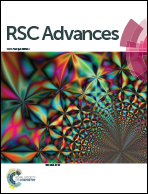Molten salt synthesis of nano-sized Li4Ti5O12 doped with Fe2O3 for use as anode material in the lithium-ion battery
Abstract
A single-phase Li4Ti5−xFexO12 (x = 0, 0.1, 0.2, 0.3) with spinel structure has been synthesized in LiCl–KCl molten salts with a stoichiometric molar ratio of 4 : 5 : x/2 : 20 LiOH·H2O, TiO2, Fe2O3, LiCl–KCl (x = 0, 0.1, 0.2, 0.3). The effects of Fe2O3 on the phase structure, morphology and particle size of Li4Ti5O12 were characterized by X-ray diffraction (XRD), scanning electron microscope (SEM) and transmission electron microscope (TEM) equipped with energy dispersive spectroscope (EDS). The electrochemical performances of the Li4Ti5−xFexO12 were characterized by charge/discharge curves, electrochemical impedance spectroscopy (EIS) and cyclic voltammetry (CV). The results show that Fe2O3 homogenously distributes in the crystal lattice of Li4Ti5O12 and slightly increases the lattice parameters due to Fe3+ ion doping. The addition of 0.1 molar ratio Fe2O3 to Li4Ti5O12 reduced the average particle size of Li4Ti5O12 from 1 μm to about 200 nm. The obtained Li4Ti4.8Fe0.2O12 was used as anode material for a lithium-ion battery, presenting the capacity of 173.7 mA h g−1 at 0.2 C—approaching the theoretical capacity of Li4Ti5O12 (175 mA h g−1)—and giving a capacity of 103.4 mA h g−1 at 10 C, much larger than the value of pure Li4Ti5O12 (28.7 mA h g−1). This is well explained by the EIS and CV results.


 Please wait while we load your content...
Please wait while we load your content...